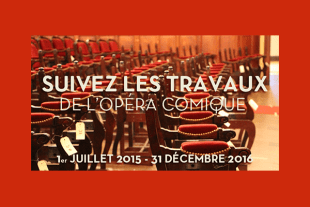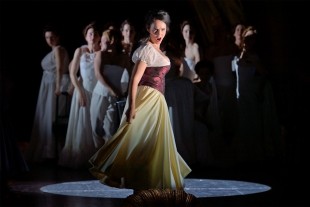The phase consisting in getting rid of old stuff, preserving valued things carefully stored and sheltered in a tent, and removing asbestos are near completion. The place is going to be clean soon. Comes a time of preparation of the premises for the installation of what led to the closing of the theater during 18 months: a brand new ventilation system, new electrical grids, better accessibility to public and private spaces for all – especially for persons with mobility impairments – and a new elevator for professionals.
Tuesday 27 October at 8 a.m. in the former dance studio on fifth floor turned into a meeting room while the contiguous Salle Mado Robin has been transformed into the renovation work headquarters. Some thirty people are there for their weekly meeting: collaborators of the OPPIC (Opérateur du Patrimoine et des Projets Immobiliers de la Culture), architects from various State and City of Paris agencies who supervise the work, representatives of the companies involved on the construction site. They are all sitting at a huge table. The atmosphere is relaxed, very few men are wearing a tie, friendly signs are exchanged. Yet there is no time for joking. Everyone has brought one’s maps, charts, notes or laptop. They are there to report and prepare what comes next. Some tension is palpable on every floor, in the offices and throughout the construction site. A fight against time is engaged as the restoration work must be completed by December 2016 for the reopening in January 2017 with Offenbach’s Fantasio directed by Thomas Jolly.
As for now, some thirty workers are on deck. They’ll be three times as many when the battle against time starts for good. But where are they?
They are to be found in the corridors – which are protected by wooden boards near what used to be the auditorium, now rigged out with a thirty-ton scaffolding – in the empty offices and in what used to be the costume workshop, wearing astronaut clothing, a hard hat, a respirator, before they disappear in a tangle heap of wood and scrap metal: wood for covering, metal for strengthening. No wonder they are seldom seen on pictures.
The costume workshop is no exception. Where fabric once prevailed, now metal beams litter the floor. An 18-step spiral staircase used to lead up to what remains one of the magical spots of Salle Favart: under the roof, overlooking Paris, the place where natural dyeing was prepared in boiling pots full of colors. Today it is completely empty. However, the glass window that gives on to Paris skyline continues to do its job and that’s fine. The sky is low, it’s cold outside. It’s magic!
In a way, the Opéra Comique is full as an egg. In the small theater, old flooring and doors are stored. And there are the smells: the smell of Jérôme Deschamps’s office when he still ran the house. Those who spent some time there know what that means. Jérôme’s office is no longer available but memory can resort to other senses. Everything has changed in Salle Favart yet certain things remain for those accustomed to the place. The Salle Bizet is cut in half, the stairs are covered with dust and yet a poster, a piece of wall or some color makes it possible to find one’s way.
This Tuesday 27 October the Salle Favart is cut in two vertically and you can go from one part to the other and then out through the fifth floor.



















